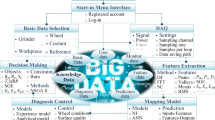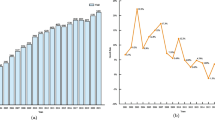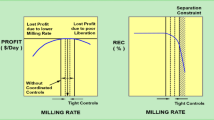Abstract
The digitization thrust on high-value manufacturing and services opens up new opportunities for ensuring total system uptime, reliability, and efficiency particularly for mission-critical high-value assets. The digitization process evolves intelligent manufacturing systems (IMS) which transforms maintenance into predictive reliability for achieving consistent quality throughout manufacturing process. This article unveils the intelligent grinding systems (IGS) for challenging grinding applications. In order to provide a better chance for value addition, previous work has been scrutinized extensively in the following aspects: grinding models, process design algorithms, and process monitoring. This then leads into an analysis of various previously designed IGS. The main focus, especially in the early 2000s, was mainly database development and parameter selection, which then shifted to process monitoring and control as particular technology advances were made. In the various goals that were investigated, it was evident that researchers were aiming for an online real-time system. This notion was driven by the advances in artificial intelligence and improved monitoring sensors, for example, acoustic emission sensors and even other unusual sensors like microphones for more economical and improved data collection and analysis. Although tremendous strides have been made, a substantial amount of work is still required in achieving a full-fledged real-time intelligent grinding system. The comprehensive findings on IGS system concludes that the real-time process update has been improved from few hours to milliseconds.








Similar content being viewed by others
Data availability
The authors confirm that the data supporting the findings of this study are available within the article.
References
DeAguiar P, Oliveira JFG (1999) Production grinding burn detection using acoustic emission and electric power signals. Scopus. https://repositorio.unesp.br/handle/11449/66028
De Aguiar P, Willett P, Webster J (1999) Acoustic emission applied to detect work-piece burn during grinding. ASTM International. https://doi.org/10.1520/STP15784S
Deiva Nathan R, Vijayaraghavan L, Krishnamurthy R (1999) In-process monitoring of grinding burn in the cylindrical grinding of steel. J Mater Process Technol 91(1-3):37–42. https://doi.org/10.1016/S0924-0136(98)00408-7
Kim HY, Kim SR, Ahn JH, Kim SH (2001) Process monitoring of centerless grinding using acoustic emission. J Mater Process Technol 111(1–3):273–278. https://doi.org/10.1016/S0924-0136(01)00533-7
Guo W, Li B, Shen S, Zhou Q (2019) An intelligent grinding burn detection system based on two-stage feature selection and stacked sparse autoencoder. Int J Adv Manuf Technol 103(5–8):2837–2847. https://doi.org/10.1007/s00170-019-03748-5
Keferstein CP, Honegger D, Thurnherr H, Gschwend B (2008) Process monitoring in non-circular grinding with optical sensor. CIRP Ann 57(1):533–536. https://doi.org/10.1016/j.cirp.2008.03.133
Mishra VK, Salonitis K (2013) Empirical estimation of grinding specific forces and energy based on a modified Werner grinding model. Procedia CIRP 8:287–292. https://doi.org/10.1016/j.procir.2013.06.104
Liu Q, Chen X, Wang Y, Gindy N (2008) Empirical modelling of grinding force based on multivariate analysis. J Mater Process Technol 203(1–3):420–430. https://doi.org/10.1016/j.jmatprotec.2007.10.058
Guo M, Li B, Ding Z, Liang SY (2016) Empirical modeling of dynamic grinding force based on process analysis. Int J Adv Manuf Technol 86:3395–3405. https://doi.org/10.1007/s00170-016-8465-z
Zahedi A, Azarhoushang B (2016) FEM based modeling of cylindrical grinding process incorporating wheel topography measurement. Procedia CIRP 46:201–204. https://doi.org/10.1016/j.procir.2016.03.179
Kundrák J, Markopoulos AP, Karkalos NE (2017) Numerical simulation of grinding with realistic representation of grinding wheel and workpiece movements: a finite volumes study. Procedia CIRP 58:275–280. https://doi.org/10.1016/j.procir.2017.03.192
Chakrabarti S, Paul S (2008) Numerical modelling of surface topography in super abrasive grinding. Int J Adv Manuf Technol 39:29–38. https://doi.org/10.1007/s00170-007-1201-y
Lan S, Jiao F (2019) Modeling of heat source in grinding zone and numerical simulation for grinding temperature field. Int J Adv Manuf Technol 103:3077–3086. https://doi.org/10.1007/s00170-019-03662-w
Nguyen TA, Butler DL (2005) Simulation of surface grinding process, part 2: interaction of the abrasive grain with the work-piece. Int J Mach Tools Manuf 45:1329–1336. https://doi.org/10.1016/j.ijmachtools.2005.01.006
Lee CW (2000) Intelligent modeling and optimization of grinding processes. Purdue University, Dissertation
Li D, Xu M, Wei C, Hu D, Xu L (2012) A dynamic threshold-based fuzzy adaptive control algorithm for hard sphere grinding. Int J Adv Manuf Technol 60:923–932. https://doi.org/10.1007/s00170-011-3661-3
Liu Q, Chen X, Gindy N (2005) Fuzzy pattern recognition of AE signals for grinding burn. Int J Mach Tools Manuf 45(7–8):811–818. https://doi.org/10.1016/j.ijmachtools.2004.11.002
Siamak M, Mohammadali K, Bahman A (2020) First steps through intelligent grinding using machine learning via integrated acoustic emission sensors. J Manuf Mater Process 4(2):35 https://www.mdpi.com/2504-4494/4/2/35
Lee CH, Jwo J, Hsieh H, Lin C (2020) An intelligent system for grinding wheel condition monitoring based on machining sound and deep learning. IEEE Access 8:58279–58289. https://doi.org/10.1109/access-2020-2982800
Giacomo Bianchi, Marco Leonesio (2019) Hybrid machine learning model-based approach for intelligent grinding. I conferenza italiana di robotica e macchine intelligenti(I-RIM2019).
Maksoud TMA, Atia MR (2004) Review of intelligent grinding and dressing operations. Mach Sci Technol 8(2):263–276. https://doi.org/10.1081/MST-200028748
Cai R, Rowe WB, Moruzzi JL, Morgan MN (2007) Intelligent grinding assistant (IGA (©))-system development part I intelligent grinding database. Int J Adv Manuf Technol 35:75–85. https://doi.org/10.1007/s00170-006-0702-4
Shin YC, Chen YT, Kumara S (1992) Framework of an intelligent grinding process advisor. J Intell Manuf 3:135–148. https://doi.org/10.1007/BF01477597
Lezanski P (2001) An Intelligent system for grinding wheel condition monitoring. J Mater Process Technol 109(3):258–263. https://doi.org/10.1016/S0924-0136(00)00808-6
Kruszyński BW, Lajmert P (2005) An intelligent supervision system for cylindrical traverse grinding. CIRP Ann 54(1):305–308. https://doi.org/10.1016/S0007-8506(07)60109-7
Brian Rowe W, Yinnan C, Moruzzi JL, Mills B (1997) A generic intelligent control system for grinding. Comput Integr Manuf Syst 10(3):231–241. https://doi.org/10.1016/S0951-5240(97)00013-X
Grabec I, Kuljanic E (1994) Characterisation of manufacturing processes based upon acoustic emission analysis by neural networks. CIRP Ann 43(1):77–80. https://doi.org/10.1016/S0007-8506(07)62168-4
Warren Liao T (2010) Feature extraction and selection from acoustic emission signals with an application in grinding wheel condition monitoring. Eng Appl Artif Intell 23(1):74–84. https://doi.org/10.1016/j.engappai.2009.09.004
Kuppuswamy R, Airey KA (2018) Feature extraction on an intelligent polycrystalline diamond insert clock testing method and prediction of product performance. Proceedings of the Institution of Mechanical Engineers, Part E: Journal of Process Mechanical Engineering 232(6):723–733. https://doi.org/10.1177/0954408917738128
Yang Z, Yu Z, Xie C, Huang Y (2014) Application of Hilbert-Huang transform to acoustic emission signal for burn feature extraction in surface grinding process. Measurement 47:14–21. https://doi.org/10.1016/j.measurement.2013.08.036
Sachin Krishnan P, Rameshkumar K (2020) Grinding wheel condition prediction with discrete hidden Markov model using acoustic emission signature. Materials Today: Proceedings. https://doi.org/10.1016/j.matpr.2019.12.428
Chen X, Limchimchol T (2006) Monitoring grinding wheel redress-life using support vector machines. Int J Autom Comput 3:56–62. https://doi.org/10.1007/s11633-006-0056-2
Zhao Z, Hou C, Duan S (2012) Online intelligent monitoring system of grinding process based on process modeling. Second International Conference on Instrumentation, Measurement, Computer, Communication and Control. Harbin-China. https://doi.org/10.1109/IMCCC.2012.80
Ilhan A, Mustafa T, Hazim EM, Levent Ç (2012) An intelligent system approach for surface roughness and vibrations prediction in cylindrical grinding. Int J Comput Integr Manuf 25(8):750–759. https://doi.org/10.1080/0951192X.2012.665185
Onishi T, Sakakura M, Okanoue T, Fujiwara K, Fujiyama Y, Ohashi K (2018) Development of the intelligent cylindrical grinding system considering the thermal deformation of a workpiece. Journal of Advanced Mechanical Design, Systems, and Manufacturing 12:5. https://doi.org/10.1299/jamdsm.2018jamdsm0105
Jiaqi Jin, Xingyu Jiang, Xinmin Zhang, Wang W (2010) Research on dynamic intelligent control system of grinding quality. 8th World Congress on Intelligent Control and Automation. Jinan-China 2192-2197. https://doi.org/10.1109/WCICA.2010.5554324
Brian Rowe W, Li Y, Mills B, Allanson DR (1996) Application of intelligent CNC in grinding. Comput Ind 31(1):45–60. https://doi.org/10.1016/0166-3615(96)00036-X
Inasaki I, Okamura K (1985) Monitoring of dressing and grinding processes with acoustic emission signals. CIRP Ann 34(1):277–280. https://doi.org/10.1016/S0007-8506(07)61772-7
Karpuschewski B, Wehmeier M, Inasaki I (2000) Grinding monitoring system based on power and acoustic emission sensors. CIRP Ann 49(1):235–240. https://doi.org/10.1016/S0007-8506(07)62936-9
Ling T, He Y (2018) Study on new monitoring of AE intelligent grinding. 2nd IEEE Advanced Information Management, Communicates, Electronic and Automation Control Conference (IMCEC). Xi'an 2018:206–209. https://doi.org/10.1109/IMCEC.2018.8469296
Xie X, Sun L (2016) Force control based robotic grinding system and application. 12th World Congress on Intelligent Control and Automation (WCICA). Guilin-China 2016:2552–2555. https://doi.org/10.1109/WCICA.2016.7578828
Hatamura Y, Nagao T, Mitsuishi M, Tanaka H, Iwata K (1989) Development of a force controlled automatic grinding system for actual NC machining centers. CIRP Ann 38(1):343–346. https://doi.org/10.1016/S0007-8506(07)62719-X
Zhang X, An W, Cao H (2012) An expert system of cubic boron nitride (CBN) grinding wheel dressing in cam grinding. Mater Manuf Process 27(10):1095–1100. https://doi.org/10.1080/10426914.2011.654167
Varghese B, Pathare S, Gao R, Guo C, Malkin S (2000) Development of a sensor-integrated ‘intelligent’ grinding wheel for in-process monitoring. CIRP Ann 49(1):231–234. https://doi.org/10.1016/S0007-8506(07)62935-7
Inasaki I (1999) Sensor fusion for monitoring and controlling grinding processes. Int J Adv Manuf Technol 15:730–736. https://doi.org/10.1007/s001700050125
Jacso A, Matyasi G, Szalay T (2019) The fast constant engagement offsetting method for generating milling tool paths. Int J Adv Manuf Technol 103:4293–4305. https://doi.org/10.1007/s00170-019-03834-8
Liang B, Iwnicki SD, Zhao Y (2013) Application of power spectrum, cepstrum, higher order spectrum and neural network analyses for induction motor fault diagnosis. Mech Syst Signal Process 39(1-2):342–360. https://doi.org/10.1016/j.ymssp.2013.02.016
Zhu K, Wong YS, Hong GS (2009) Wavelet analysis of sensor signals for tool condition monitoring: a review and some new results. Int J Mach Tools Manuf 49(7-8):537–553. https://doi.org/10.1016/j.ijmachtools.2009.02.003
Arun A, Rameshkumar K, Unnikrishnan D, Sumesh A (2018) Tool condition monitoring of cylindrical grinding process using acoustic emission sensor. Materials Today: Proceedings 5(5):11888–11899. https://doi.org/10.1016/j.matpr.2018.02.162
Yang Z, Yu Z (2012) Grinding wheel wear monitoring based on wavelet analysis and support vector machine. Int J Adv Manuf Technol 62:107–121. https://doi.org/10.1007/s00170-011-3797-1
Sanidhya P, Elangovan M, Sugumaran V (2014) Tool condition monitoring using K-star algorithm. Expert Syst Appl 41(6):2638–2643. https://doi.org/10.1016/j.eswa.2013.11.005
Jaitha A (2017) An introduction to Bayesian network theory and usage. Dissertation, Claremont College https://publications.idiap.ch/downloads/reports/2000/rr00-03.pdf
Hanafy M, Elmaraghy H (2017) Integrated products–systems design environment using Bayesian networks. Int J Comput Integr Manuf 30(7):708–723. https://doi.org/10.1080/0951192X.2015.1099072
Cai R, Morgen MN (2007) Development of intelligent grinding database. Key Eng Mater 329:21–26. https://doi.org/10.4028/www.scientific.net/kem.329.21
Karadogan A, Kahriman A, Ozer U (2008) Application of fuzzy set theory in the selection of underground mining method. J South Afr Inst Min Metall 108(2):73–79 http://www.scielo.org.za/scielo.php?script=sci_arttext&pid=S2225-62532008000200002&lng=en&nrm=iso
Funding
This project was supported by fund NRF GRANT: INCENTIVE FUNDING FOR RATED RESEARCHERS (IPRR)–South Africa through Reference: IFR150204113619 and Grant No: 96066.
Author information
Authors and Affiliations
Contributions
Fungai Jani: investigation, methodology, and writing—original draft. Samiksha Naidoo: investigation, conceptualization, methodology, validation, and support writing—original draft. Quintin de Jongh: investigation, conceptualization, methodology, validation, and support writing—original draft. Ramesh Kuppuswamy: supervision, project administration, resources, validation, and investigation.
Corresponding author
Ethics declarations
Ethical approval
The author(s) confirm that the paper has not been published previously in any form or language, that it is not under consideration for publication elsewhere and does not contain material which has been published previously. The results are presented clearly, honestly, and without fabrication, falsification or inappropriate data manipulation.
Consent to participate
Not applicable.
Consent to publish
Not applicable.
Competing interest
The authors declare no competing interests.
Disclaimer
The views expressed and the conclusions drawn in this paper are those of the authors and cannot necessarily be attributed to the references.
Additional information
Publisher’s note
Springer Nature remains neutral with regard to jurisdictional claims in published maps and institutional affiliations.
Rights and permissions
About this article
Cite this article
Kuppuswamy, R., Jani, F., Naidoo, S. et al. A study on intelligent grinding systems with industrial perspective. Int J Adv Manuf Technol 115, 3811–3827 (2021). https://doi.org/10.1007/s00170-021-07315-9
Received:
Accepted:
Published:
Issue Date:
DOI: https://doi.org/10.1007/s00170-021-07315-9




